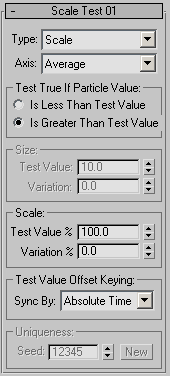Scale Test lets the particle system check particle scaling, or particle size before or after scaling, and branch accordingly. The test provides a variety of axis options for measuring scale or size.
You can use this test to cause a change in behavior based on size. For example, a bubble could grow to a certain size, and then pop. Or an object could shrink in size until it falls under the influence of a force, like wind.
Interface

The user interface appears in the parameters panel, on the right side of the Particle View dialog.
- Type
- Choose the type of measurement to test. You can test actual scaling, or the size before or after scaling. Default=Scale.
For example, if the X-axis size of a particle's bounding box starts out at 10 system units, and you then use the Scale operator to scale it by 150% on the X axis, the pre-scale size is 10, and the post-scale size is 15. And, of course, the scale is 150.
Note: Particle Flow measures particle size based on each particle’s bounding-box dimensions in the particle's local coordinate space. With the low-polygon Shape options Tetra and Sphere, the result of this measurement might not be the same as the Shape operator’s Size value.- PreScale Size Tests the size before scaling.
- PostScale Size Tests the size after scaling.
- Scale Tests the scaling percentage.
- Axis
- Choose the axis to measure. Default=Average.
- Average Obtains an average measurement by adding the sizes on all three axes and then dividing by three.
- Minimum Uses the smallest dimension.
- Median Uses the middle dimension in order of size. For example, if the particle dimensions are X=5, Y=6, Z=12, then the number compared to Test Value would be 6.
- Maximum Uses the largest dimension.
- X/Y/Z Uses the specified dimension.
Test True if Particle Value group
Lets you specify whether the test passes particles on to the next event if the speed test succeeds or fails. Available for all tests except True When Accelerates/Decelerates. Default=Is Greater Than Test Value.
By default, Scale Test returns True if the value tested for exceeds the Test Value quantity, but you can alternatively choose Is Less Than Test Value. For example, if you set Type to Scale and set Test Value=150 and Variation=0, and choose Is Less Than Test Value, a particle will move to the next event only when its scaling factor is less than 150%.
Size group
These settings are available when Type is set to PreScale Size or PostScale Size.
- Test Value
- The specific size to test for. Default=10.0.
- Variation
- The amount by which the value tested for can vary randomly. Default=0.0.
To obtain the actual test value for each particle, the system multiplies the Variation value by a random number between –1.0 and 1.0, and then adds the result to the Test Value setting. For example, if Test Value=10 and Variation=5, then the tested value for each particle would be between 5 and 15.
Scale group
These settings are available when Type is set to Scale.
- Test Value
- The specific scaling factor to test for. Default=100%.
- Variation
- The amount by which the value tested for can vary randomly. Default=0.0%.
To obtain the actual test value for each particle, the system multiplies the Variation value by a random number between –1.0 and 1.0, and then adds the result to the Test Value setting. For example, if Test Value=100% and Variation=10%, then the tested value for each particle would be between 90% and 110%.
Test Value Offset Keying group
- Sync By
- Choose the time frame to use when animating Test Value and Variation:
- Absolute Time Any keys set for parameters are applied at the actual frames for which they're set.
- Particle Age Any keys set for parameters are applied at the corresponding frames of each particle's existence.
- Event Duration Any keys set for parameters are applied to each particle starting when it first enters the event.
Uniqueness group
The Uniqueness setting enables randomization of the test value variation. Available only when either Variation value exceeds 0.0.
- Seed
- Specifies a randomization value.
- New
- Calculates a new seed using a randomization formula.